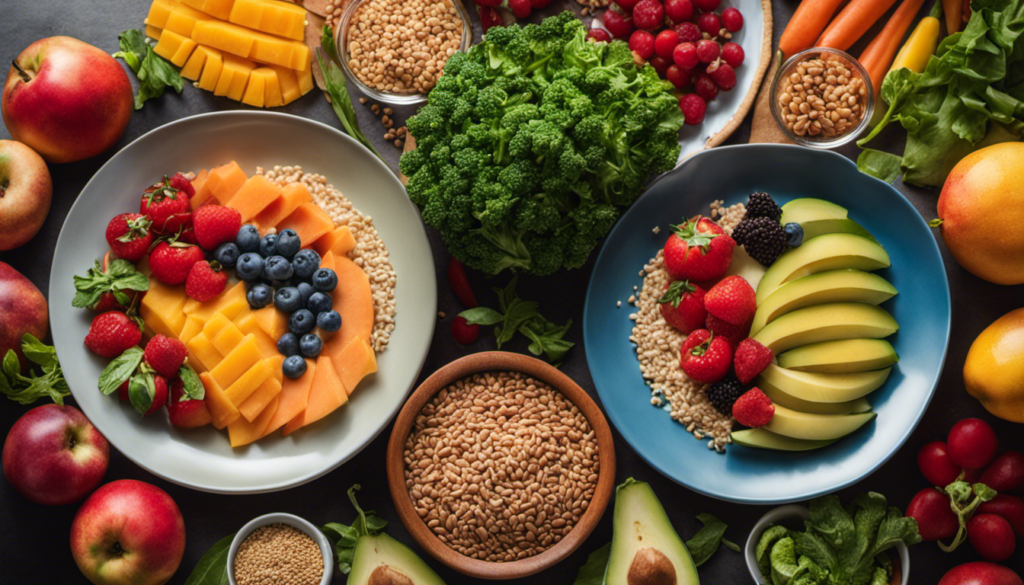Are you ready to take the plunge and make a change in your eating habits? Well, buckle up because we’re about to dive into the differences between a standard diet and a keto diet for beginners.
It’s time to separate the wheat from the chaff and get down to the nitty-gritty. You’ve probably heard the buzz about keto, but what exactly sets it apart from the traditional ways of eating?
In this article, we’ll explore the macronutrient composition, metabolic state, weight loss potential, food choices and restrictions, as well as the potential health benefits of these two diets.
Armed with this knowledge, you’ll be able to make an informed decision about which path to take on your journey to a healthier you.
So, let’s get started and discover the ins and outs of the standard diet versus the keto diet for beginners.
Key Takeaways
- Macronutrient composition: A standard diet consists of 50-60% carbohydrates, 10-20% proteins, and 20-30% fats, while a keto diet for beginners emphasizes 70-75% fats, 20-25% proteins, and 5-10% carbohydrates.
- Metabolic state: The keto diet induces ketosis, where the body uses fat for energy, resulting in increased energy, mental clarity, and reduced hunger. However, there may be temporary symptoms during the transition period, known as keto flu, such as fatigue, irritability, and difficulty concentrating. Proper hydration and electrolyte replenishment are important during this time.
- Weight loss potential: The keto diet promotes weight loss by shifting the body’s fuel source from glucose to fat. Incorporating exercise and meal planning can enhance the weight loss journey. Regular physical activity helps maintain muscle mass, increases metabolism, and optimizes weight loss potential.
- Food choices and restrictions: The keto diet encourages the consumption of meat, fish, eggs, vegetables, and healthy fats. Meal planning ensures a balanced and nutrient-rich diet. Being creative and finding keto-friendly alternatives for favorite foods can make the diet more sustainable. It’s important to understand the adjustments and restrictions of the keto diet before starting.
Macronutrient Composition
The macronutrient composition differs significantly between a standard diet and a keto diet for beginners.
In a standard diet, the emphasis is on a balanced intake of carbohydrates, proteins, and fats, with a higher proportion of carbohydrates. According to dietary guidelines, the recommended nutrient ratios for a standard diet are about 50-60% carbohydrates, 10-20% proteins, and 20-30% fats.
On the other hand, a keto diet for beginners focuses on a low-carbohydrate and high-fat approach. The nutrient ratios in a keto diet typically involve consuming around 70-75% fats, 20-25% proteins, and only 5-10% carbohydrates. This drastic reduction in carbohydrates forces the body to enter a metabolic state called ketosis, where it starts utilizing stored fats as the primary source of energy.
Transitioning into the subsequent section about ‘metabolic state’, it is important to understand how ketosis affects the body’s metabolism.
Metabolic State
Contrasting a standard diet with a keto diet, beginners can enter a metabolic state called ketosis. In this state, the body starts relying on fat for fuel instead of carbohydrates.
This shift in metabolic rate can have several effects on the body. Some people experience increased energy levels, improved mental clarity, and reduced hunger. However, it’s important to note that entering ketosis may also cause some temporary symptoms such as fatigue, irritability, and difficulty concentrating. These symptoms are commonly known as the ‘keto flu‘ and usually subside within a few days.
It’s crucial to stay properly hydrated and replenish electrolytes during this transition period.
Moving on to the next section about weight loss potential, the metabolic state of ketosis can significantly contribute to shedding excess pounds.
Weight Loss Potential
Discover the incredible weight loss potential that a keto diet can unlock for you. When it comes to shedding those extra pounds, a keto diet can be highly effective.
By drastically reducing your carbohydrate intake and increasing your consumption of healthy fats, your body enters a state of ketosis. This metabolic state shifts your body’s primary fuel source from glucose to fat, allowing you to burn stored fat for energy.
But it’s not just about what you eat; incorporating exercise routines and meal planning strategies can further enhance your weight loss journey. Regular physical activity and a well-balanced meal plan can help you maintain muscle mass, increase your metabolism, and optimize your weight loss potential.
So, as we move on to discussing food choices and restrictions, keep in mind the importance of exercise and meal planning in achieving your weight loss goals.
Food Choices and Restrictions
One potential objection to a keto diet for beginners is the perceived restriction of certain food choices. While it is true that a keto diet eliminates or severely limits certain foods, it is important to note that meal planning can help ensure a balanced and nutrient-rich diet.
Here are four things to consider:
1) Variety: A keto diet encourages the consumption of a wide range of foods, including meat, fish, eggs, vegetables, and healthy fats. This can actually lead to a more diverse and interesting meal plan.
2) Nutrient deficiencies: Cutting out certain food groups may increase the risk of nutrient deficiencies. However, careful meal planning can help address this by incorporating a variety of nutrient-dense foods.
3) Flexibility: Contrary to popular belief, a keto diet doesn’t mean you have to give up all your favorite foods. With some creativity, you can find keto-friendly alternatives for many dishes.
4) Long-term sustainability: While a keto diet may require some adjustments at first, it can be a sustainable way of eating for many people once they get the hang of it.
Transitioning to the next section, let’s explore the potential health benefits of a keto diet for beginners.
Potential Health Benefits
Explore the potential health benefits you can experience by following a keto diet for beginners.
One of the key benefits is improved cognitive function. Research suggests that the ketogenic diet may enhance brain health by increasing the production of ketones, which are an alternative energy source for the brain. This can lead to improved focus, mental clarity, and overall brain function.
In addition, a keto diet has been shown to reduce inflammation in the body. Chronic inflammation has been linked to various health issues, including heart disease, diabetes, and certain types of cancer. By limiting carbohydrate intake and promoting healthy fats, the keto diet can help lower inflammation levels and potentially reduce the risk of these chronic conditions.
However, it’s important to note that the keto diet may not be suitable for everyone, especially those with certain medical conditions or on certain medications. It’s always best to consult with a healthcare professional before making any significant changes to your diet.
Frequently Asked Questions
Can I still eat fruits and vegetables on a keto diet?
Yes, you can still enjoy fruits and vegetables on a keto diet. However, it’s important to choose wisely. While fruits are generally higher in natural sugars, some low-carb options like berries can be included in moderation.
Vegetables like leafy greens, cauliflower, and broccoli are excellent choices due to their low carb content.
Remember, the keto diet aims to reduce blood sugar and promote weight loss, so it’s essential to monitor your carb intake.
How long does it take for the body to enter a state of ketosis?
It typically takes your body around 2-7 days to enter a state of ketosis.
This is when your body adapts to using ketones, instead of glucose, as its primary source of energy.
The time it takes to enter ketosis can vary based on factors such as your individual metabolism, exercise levels, and carbohydrate intake.
Regular exercise can help speed up the process by depleting glycogen stores and promoting ketone production.
Remember to listen to your body and consult a healthcare professional before making any significant dietary changes.
Will I experience any side effects when transitioning into a keto diet?
Get ready to tackle the transition into a keto diet! While adjusting to a low carb, high fat lifestyle, it’s common to experience some side effects.
These can include headaches, fatigue, and irritability. However, don’t fret! You can minimize these symptoms by gradually reducing your carb intake, staying hydrated, and ensuring you’re getting enough electrolytes.
Remember, every person is different, so listen to your body and make adjustments accordingly.
Can I consume dairy products while following a keto diet?
Yes, you can consume dairy products while following a keto diet. Dairy options on a keto diet include cheese, butter, cream, and full-fat yogurt. These products are high in fat and low in carbs, making them suitable for a ketogenic lifestyle.
However, some people choose to exclude dairy from their keto diet due to potential benefits such as improved digestion and reduced inflammation. It’s important to listen to your body and choose what works best for you.
Is it necessary to count calories on a keto diet?
Counting calories on a keto diet is not necessary, but counting macros can be beneficial.
While calorie restriction is often a focus in traditional diets, a keto diet emphasizes the balance of macronutrients.
By tracking your intake of carbohydrates, protein, and fat, you can ensure you are staying within the recommended ranges for a successful keto diet.
This approach can help you achieve the benefits of a keto diet, such as improved weight loss, increased energy, and better blood sugar control.
Conclusion
When comparing a standard diet and a keto diet for beginners, there are several key differences to consider.
Firstly, a standard diet typically emphasizes a balanced macronutrient composition. This means that you would consume a moderate amount of carbohydrates, proteins, and fats. On the other hand, a keto diet focuses on high fat intake and restricts carbohydrate consumption to induce a metabolic state called ketosis.
In terms of benefits, a keto diet may offer unique advantages due to the metabolic changes it triggers. Ketosis has been associated with increased fat burning, improved mental clarity, and reduced hunger cravings. However, it’s important to note that these benefits may vary from person to person.
Both diets have the potential for weight loss, but the approach is different. While a standard diet typically focuses on creating a calorie deficit, a keto diet relies on the body’s ability to burn fat for fuel.
When it comes to food choices, both diets offer a range of options with their own restrictions. A standard diet allows for a wider variety of foods, including carbohydrates like fruits, grains, and legumes. On the other hand, a keto diet restricts carbohydrate-rich foods and encourages the consumption of high-fat foods such as avocados, nuts, and fatty meats.
Ultimately, the choice between a standard diet and a keto diet depends on your individual goals and preferences. It’s important to consider factors such as your health, lifestyle, and dietary restrictions before making a decision.








